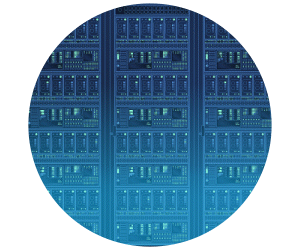In most emergency scenarios, state IT leaders would turn to both traditional data centers and modular data centers, Chhabra says. Modular data centers in remote areas can link to traditional data centers using a satellite connection, Chhabra adds.
Preplanning requirements notwithstanding, prefabricated modular data centers, or PMDCs, appeal to state and local governments because they can be set up faster than traditional data centers, says Vlad Galabov, head of the cloud and data center research practice at Omdia.
“PMDCs enable accelerated project completion, which has made them increasingly popular in the market,” Galabov says.
Examples of Modular Data Centers and How They’re Used
An all-in-one module, such as the AWS Modular Data Center, comes with networking, cooling and power distribution equipment, and state agencies can run low latency software from their site.
“An all-in-one module provides enough capacity for most enterprise use cases,” Galabov says.
In other cases, facilities or agencies may only require an increase in power distribution capacity.
“Power modules are very popular as a way to expand existing data center power capacity and are much needed as hot AI-optimized server clusters get deployed at scale,” Galabov says.
Users can opt for satellite connectivity as their network connection. For instance, AWS has helped government agencies deploy self-contained modular data centers in isolated environments.
To support the growing interest in artificial intelligence, Vertiv’s 360AI offers a pre-engineered infrastructure geared to AI test environments, Aziz notes.
Modular data centers can also provide flexibility for state and local leaders looking to adopt generative AI for citizen services, allowing agencies to scale up compute capacity, storage and cooling based on the needs of AI solutions, IDC Research Director Sean Graham told StateTech.
RELATED: Modernizing your data center will prepare you for the next phase of AI.
Other modular data centers, such as that of California Public University, might consist of an uninterruptible power supply (UPS), server cabinets, air conditioning and data center monitoring systems.
In September, the Department of Commerce and the National Oceanic and Atmospheric Administration announced $100 million in funding to cover construction of a modular data center at the NOAA Environmental Security Computing Center in Fairmont, W.Va. The unit will connect to the facility’s high-performance computing center. NOAA HPC centers in Colorado, New Jersey and Tennessee might also receive modular data center additions, according to the Department of Commerce and NOAA.
While PMDCs offer scalable modular deployment, micro-modular data centers are relatively smaller and could consist of just a single server rack, Aziz says.
DISCOVER: State and local governments can benefit from data center sustainability.
Amid the increasing need to support high-density workloads, Aziz says, micro-modular data centers can be used to speed deployment of compute capacity in data halls alongside deployment of PMDCs such as power modules.
“A micro-modular solution typically integrates computing, networking, storage components, power, cooling and monitoring in a condensed form factor,” he says. “Multirack micro data centers expand the single-rack concept by incorporating multiple server racks, creating a more scalable infrastructure.”
Modular Data Center vs. Traditional Data Center
Modular data centers can be deployed more quickly than a traditional data center. Compared with traditional data center, which may take about 12 to 18 months to build (some even take years), a micro data center can be assembled within a few days or weeks, while a PMDC takes about four to six months to assemble, Aziz says.
In addition, constructing a large facility as part of a traditional data center for a specific purpose requires compliance with strict standards, which raises up-front costs, says Aziz. These costs include land acquisition, building materials, compliance and certification, and labor. By contrast, state leaders can deploy a modular data center on a “pay as you grow” basis, Aziz says.
“This approach avoids the need for huge capital outlays, enabling operators to achieve cost efficiency amid the increasing need to scale up onsite computing capacity,” he says.












